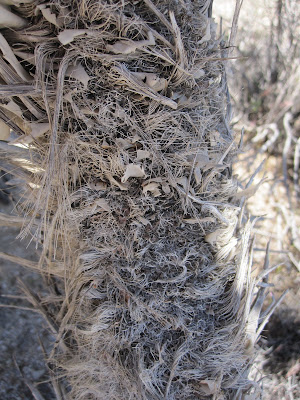Joshua tree,
also known as yucca palm,
tree yucca
and palm tree yucca (Yucca brevifolia)
belongs to the genus Yucca and is native to southern and eastern California, southern Nevada, extreme southwestern Utah and mid-central to western Arizona. It is found nowhere else in the world. The range mostly coincides with the Mojave Desert where it is considered one of the major indicator species for that desert. It got its name from Mormon settlers who crossed the Mojave Desert. The trees reminded them of the Biblical story of Joshua who reached his hands up to the sky in prayer. It grows about 3 inches per year for the first 10 years,
then about 1.5 inches per year thereafter. The trunk lacks growth rings.
Rather, it is made of thousands of small fibers
which makes it difficult to determine age. It is top-branch heavy, but also has an extensive root system, roots reaching up to 36 feet away. It can live hundreds of years and some specimans as much as 1,000 years. New plants can grow from seeds, but they can also grow from rhizones that spread out around the tree.
The leaves are dark green, linear, bayonet-shaped and broad at the base, tapering to a sharp point. They are in a dense spiral arrangment at the apex of the stems.
Leaf margins are white and separate. Flowers are produced from February to late April in panicles, with six creamy white to green sepals croweded into 12 to 18 inch clusters. They do not bloom every year. Blooming is dependent on rainfall at the proper time and they also need a winter freeze. When they bloom, the yucca moth pollinates the flowers while laying eggs inside the flowers. The moth larvae feed on the seeds, but enough seeds are left behind to produce more trees. The fruit that is produced is a green-brown,
elliptical and contains many flat seeds.
They do not branch until they bloom. Cahuilla Indians used the leaves to weave sandals and baskets and harvested the seeds and flower buds to eat. There is concern that if we have climate change, the Joshua Tree may have a hard time migrating to favorable climates due to extinction of the Shasta ground sloth about 13,000 years ago. Joshua tree leaves, fruit and seeds have been found in their dung suggesting that the sloths might have been key to their dispersal.












No comments:
Post a Comment